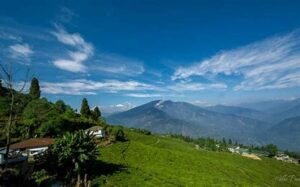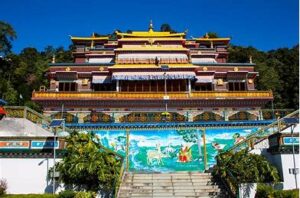In the realm of traditional Buddhist art, few names resonate as profoundly as Lharipa Nima Tshering Bhutia, a master of Thangka painting who has brought national attention to this ancient and sacred art form. Based in the northeastern Indian state of Sikkim, Bhutia has not only preserved but revitalized this intricate tradition, ensuring that it continues to thrive in both religious and artistic spheres.
The Cultural and Spiritual Significance of Thangka Art
Thangka painting is a revered artistic tradition rooted deeply in Tibetan Buddhism. These intricate scroll paintings often depict deities, mandalas, and important spiritual narratives, serving as visual aids in meditation and tools for teaching. Traditionally painted on cotton or silk, Thangkas are more than mere artworks; they are windows into a spiritual dimension, guiding practitioners toward enlightenment.
Each Thangka is rich with symbolism and detail, often taking months to complete. The process involves deep spiritual dedication and technical mastery, making it a true spiritual and artistic endeavor. In this context, artists like Lharipa Nima Tshering Bhutia are not just painters; they are cultural custodians and spiritual practitioners.
Early Life and Artistic Journey
Lharipa Nima Tshering Bhutia’s artistic journey began in Sikkim, where he was drawn to the sacred beauty of Buddhist art from a young age. His passion led him to pursue rigorous training under established masters in the region. Over the years, he mastered the complex techniques of Thangka painting, learning the sacred geometry, iconography, and spiritual practices associated with the art.
His early works quickly gained recognition for their authenticity, attention to detail, and spiritual depth. As his reputation grew, Bhutia became a sought-after artist for temples, monasteries, and collectors. However, he remained committed to the core values of the tradition, creating art not for profit but for preservation and devotion.
National Recognition and Notable Works
Lharipa Nima Tshering Bhutia’s contributions to Indian art were nationally recognized in 1994, when he received the National Award for his masterpiece, the “Thangka of White Tara.” This painting depicts White Tara, a revered deity in Tibetan Buddhism symbolizing compassion, healing, and longevity. The intricate work features her with seven eyes—on her forehead, palms, and soles—symbolizing her ability to see all suffering in the world.
This national recognition marked a significant moment not only for Bhutia but for Thangka art as a whole. It brought attention to the depth and importance of Himalayan Buddhist art within the broader Indian cultural landscape, helping to ensure its preservation and appreciation.
Teaching and Cultural Preservation
Beyond creating extraordinary pieces of art, Bhutia has played a pivotal role in mentoring young artists and passing on his knowledge. His association with institutions like the Directorate of Handicrafts & Handloom in Sikkim reflects his commitment to education and cultural continuity. Through workshops, training programs, and collaborative projects, he has helped to build a new generation of Thangka artists who carry forward this sacred tradition.
Bhutia’s role as a teacher extends beyond technique. He emphasizes the spiritual dimensions of the art, ensuring that students understand the religious and philosophical significance of the images they create. For him, Thangka painting is a meditative and devotional act, not merely a craft.
Exhibitions and Global Recognition
Lharipa Nima Tshering Bhutia’s work has been featured in several national and international exhibitions. His Thangkas have been displayed in art galleries, museums, and cultural festivals, allowing global audiences to engage with the unique spiritual and aesthetic dimensions of Himalayan Buddhist art.
These exhibitions have helped raise awareness of Sikkim’s rich cultural heritage and the importance of preserving indigenous art forms. Bhutia’s work has also been included in digital archives and educational platforms, such as Google Arts & Culture, which has featured curated collections on Sikkimese and Buddhist art.
Challenges in Preserving Traditional Art
Despite his achievements, Bhutia has spoken about the challenges that Thangka artists face today. Modernization, declining interest among youth, and the rise of mass-produced spiritual items have threatened the survival of this intricate art form. The painstaking effort required to create a single Thangka cannot compete with machine-made replicas in terms of cost and convenience.
To counter these challenges, Bhutia continues to advocate for greater governmental and institutional support. He emphasizes the need for art education programs, heritage funding, and awareness campaigns to protect and promote traditional crafts. His voice has been instrumental in influencing policies that support indigenous artisans across Northeast India.
The Artistic Legacy of Lharipa Nima Tshering Bhutia
Lharipa Nima Tshering Bhutia’s legacy is multifaceted. As an artist, he has enriched the visual language of Buddhist spirituality with his masterful Thangkas. As a teacher, he has nurtured new talents and expanded the community of Thangka practitioners. As a cultural ambassador, he has brought the art of Sikkim to national and international platforms.
His life and work exemplify how traditional art can remain relevant and vibrant in the modern world when rooted in authenticity, passion, and community engagement. His efforts have not only preserved a spiritual heritage but have also inspired a renewed appreciation for the arts of Northeast India.
Inspiring Future Generations
Bhutia’s influence continues to inspire young artists across Sikkim and beyond. Through storytelling, mentorship, and demonstration, he introduces students to the transformative power of sacred art. His message is clear: art is not just a profession; it is a way of life, a means of connecting with the divine, and a vehicle for cultural preservation.
In a world increasingly dominated by fleeting digital experiences, Bhutia’s Thangkas remind us of the value of patience, mindfulness, and devotion. Each stroke of the brush, each layer of color, is an act of reverence—a tradition that he has kept alive for over four decades.
Conclusion
Lharipa Nima Tshering Bhutia is more than an award-winning Thangka painter. He is a guardian of an ancient legacy, a bridge between generations, and a cultural icon of Sikkim and the Eastern Himalayas. His life’s work illustrates how art, when rooted in tradition and purpose, can transcend time and transform lives.
As interest in indigenous arts continues to grow, the contributions of artists like Bhutia serve as both inspiration and instruction. Through his paintings, teachings, and advocacy, he has left an indelible mark on the world of art and spirituality—a legacy that will endure through every canvas, every student, and every prayerful gaze upon his Thangkas.






